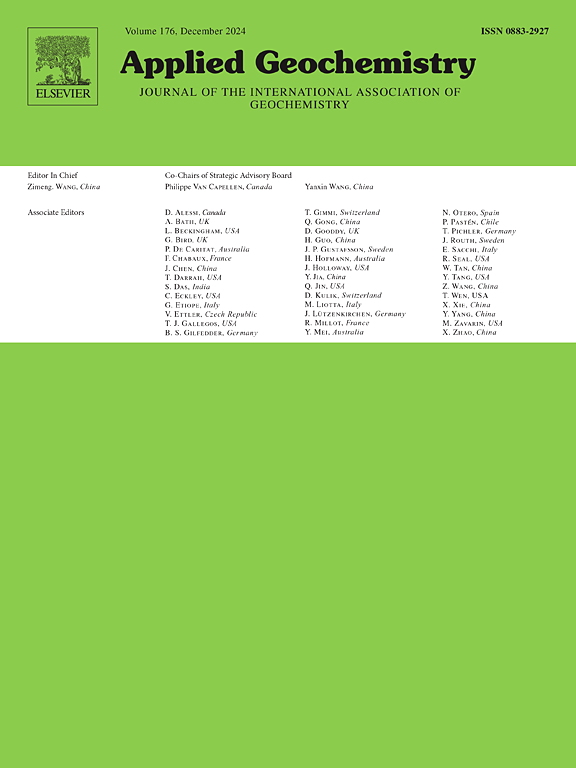用于二氧化碳地质封存的玄武岩溶解过程中矿物的特殊反应
IF 3.4
3区 地球科学
Q1 GEOCHEMISTRY & GEOPHYSICS
引用次数: 0
摘要
在二氧化碳饱和条件下进行了玄武岩颗粒(粒度:0.841-1.190 毫米)的溶解实验,以研究与二氧化碳地质封存相关的矿物学变化和流体化学动力学。实验最初在 35 °C 下进行(最多 137 天),随后在 50 °C 下进行(最多 210 天)。使用扫描电子显微镜与背散射电子成像(SEM-BSE)、电子探针显微分析(EPMA)和 X 射线衍射(XRD)进行了矿物学分析。最初的溶解阶段以橄榄石的快速溶解为特征,导致镁(Mg)和铁(Fe)的大量早期释放。温度升高到 50 °C后,拉长石的溶解变得越来越明显,增强了钙(Ca)、镁(Mg)和铝(Al)的移动。SEM-BSE 分析显示橄榄石晶粒上有明显的溶解纹理,其特征是明显的镁贫化和铁富集。流体化学结果反映了这些矿物学变化,表明初始镁释放迅速,橄榄石持续溶解产生的硅(Si)和铁持续被调动,温度升高后由于斜长石(拉长石)溶解增加导致钙和铝浓度升高,其次是辉石。根据溶解硅浓度的下降推断,二次硅沉淀发生在反应的后期阶段。这些发现强调了温度和矿物特定的溶解行为,为优化玄武岩封存二氧化碳提供了重要启示。本文章由计算机程序翻译,如有差异,请以英文原文为准。

Specific responses of minerals during the dissolution of basalt for geological storage of CO2
Dissolution experiments involving basalt grains (grain size: 0.841–1.190 mm) were conducted under CO2-saturated conditions to investigate mineralogical changes and fluid chemistry dynamics relevant to geological CO2 storage. The experiments were initially performed at 35 °C (up to 137 days) and subsequently at 50 °C (up to 210 days). Mineralogical analyses were conducted using scanning electron microscopy with backscattered electron imaging (SEM-BSE), electron probe microanalysis (EPMA), and X-ray diffraction (XRD). The initial dissolution stage was characterized by rapid olivine dissolution, causing substantial early release of magnesium (Mg) and iron (Fe). Labradorite dissolution became increasingly significant after the temperature increase to 50 °C, enhancing mobilization of calcium (Ca), magnesium (Mg), and aluminum (Al). SEM-BSE analyses revealed distinctive dissolution textures on olivine grains, characterized by pronounced Mg depletion and Fe enrichment. Fluid chemistry results reflected these mineralogical changes, indicating rapid initial Mg release, sustained mobilization of silicon (Si) and Fe from ongoing olivine dissolution, and elevated Ca and Al concentrations after temperature elevation due to increased dissolution of plagioclase (labradorite) and, to a lesser extent, augite. Secondary silica precipitation occurred during later reaction stages, inferred from decreasing dissolved Si concentrations. These findings emphasize temperature- and mineral-specific dissolution behaviors, providing critical insights for optimizing basalt-hosted CO2 sequestration.
求助全文
通过发布文献求助,成功后即可免费获取论文全文。
去求助
来源期刊

Applied Geochemistry
地学-地球化学与地球物理
CiteScore
6.10
自引率
8.80%
发文量
272
审稿时长
65 days
期刊介绍:
Applied Geochemistry is an international journal devoted to publication of original research papers, rapid research communications and selected review papers in geochemistry and urban geochemistry which have some practical application to an aspect of human endeavour, such as the preservation of the environment, health, waste disposal and the search for resources. Papers on applications of inorganic, organic and isotope geochemistry and geochemical processes are therefore welcome provided they meet the main criterion. Spatial and temporal monitoring case studies are only of interest to our international readership if they present new ideas of broad application.
Topics covered include: (1) Environmental geochemistry (including natural and anthropogenic aspects, and protection and remediation strategies); (2) Hydrogeochemistry (surface and groundwater); (3) Medical (urban) geochemistry; (4) The search for energy resources (in particular unconventional oil and gas or emerging metal resources); (5) Energy exploitation (in particular geothermal energy and CCS); (6) Upgrading of energy and mineral resources where there is a direct geochemical application; and (7) Waste disposal, including nuclear waste disposal.
 求助内容:
求助内容: 应助结果提醒方式:
应助结果提醒方式:


